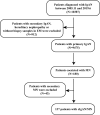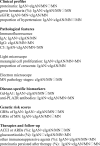Concurrent IgA Nephropathy and Membranous Nephropathy, Is It an Overlap Syndrome?
- PMID: 35359934
- PMCID: PMC8961684
- DOI: 10.3389/fimmu.2022.846323
Concurrent IgA Nephropathy and Membranous Nephropathy, Is It an Overlap Syndrome?
Erratum in
-
Corrigendum: Concurrent IgA nephropathy and membranous nephropathy, is it an overlap syndrome?Front Immunol. 2023 Jun 9;14:1218427. doi: 10.3389/fimmu.2023.1218427. eCollection 2023. Front Immunol. 2023. PMID: 37359520 Free PMC article.
Abstract
IgA nephropathy (IgAN) and membranous nephropathy (MN) are common glomerulonephritis, the presence of which in the same patient- concurrent of IgAN and MN (cIgAN/MN) has been described occasionally. This study aims to show clinical-pathological features of cIgAN/MN and attempts to suggest underlying pathogenesis using disease-specific biomarkers and a genomics approach. This retrospective cohort study described the clinical and pathological data from 137 patients with cIgAN/MN diagnosed in Peking University First Hospital from 2005 to 2019. One hundred primary IgAN and 100 MN cases were randomly selected as disease controls between the same time interval. Moreover, disease-specific biomarkers and polygenic risk score models were conducted to reveal the underlying pathogenesis. The median age of the cIgAN/MN cases was 45-year-old, and 46% were women. Compared to IgAN, patients with cIgAN/MN had a higher level of 24-hour proteinuria excretion but lower microscopic hematuria. They had a lower median level of galactose-deficient IgA1 (Gd-IgA1, 4.00 versus 5.45 μg/ml, P=0.002) as well as the standardized genetic risk scores of developing IgAN (GRSs: 0.05 versus 0.68, P<0.001). Compared to MN, patients with cIgAN/MN had a lower proportion of nephrotic syndrome and a lower level of albumin-to-creatinine ratio. However, the 24-hour proteinuria levels, serum lipid profiles, proportion of hypertension, and pathology classification were similar. Patients with cIgAN/MN had lower levels of plasma autoantibodies against the M-type transmembrane phospholipase A2 receptor (PLA2R) (11.23 versus 36.59 U/ml, P=0.005). Intriguingly, there were no statistical differences in standardized GRSs of developing MN between them (2.77 versus 3.02, P=0.326). Compared to IgAN, cIgAN/MN may lean towards MN more according to clinical-pathological features, disease-specific biomarker levels, and disease-specific genetic risk scores.
Keywords: IgA nephropathy; anti-phospholipase A2 receptor; galactose-deficient IgA1; polygenic risk score; primary membranous nephropathy.
Copyright © 2022 He, Cui, Zhou, Chen, Li, Zhang, Wang, Gan, Liu, Shi, Zhu, Hou, Lv and Zhang.
Conflict of interest statement
The authors declare that the research was conducted in the absence of any commercial or financial relationships that could be construed as a potential conflict of interest.
Figures






Comment in
-
IgA nephropathy associated with anti-PLA2R antibody positive: a case report.Int Urol Nephrol. 2022 Nov;54(11):3043-3044. doi: 10.1007/s11255-022-03242-0. Epub 2022 May 19. Int Urol Nephrol. 2022. PMID: 35588342 No abstract available.
Similar articles
-
Characteristics of patients with coexisting IgA nephropathy and membranous nephropathy.Ren Fail. 2018 Nov;40(1):213-218. doi: 10.1080/0886022X.2018.1455591. Ren Fail. 2018. PMID: 29619862 Free PMC article.
-
Specific immune biomarker monitoring in two children with severe IgA nephropathy and successful therapy with immunoadsorption in a rapidly progressive case.Pediatr Nephrol. 2022 Jul;37(7):1597-1603. doi: 10.1007/s00467-021-05381-5. Epub 2022 Jan 8. Pediatr Nephrol. 2022. PMID: 34997322
-
Clinicopathological Features of Membranous Nephropathy Complicated by IgA Nephropathy: A Retrospective Analysis of Seven Cases.Br J Hosp Med (Lond). 2024 Oct 30;85(10):1-13. doi: 10.12968/hmed.2024.0338. Epub 2024 Oct 29. Br J Hosp Med (Lond). 2024. PMID: 39475016
-
Biomarkers and targeted new therapies for IgA nephropathy.Pediatr Nephrol. 2017 May;32(5):725-731. doi: 10.1007/s00467-016-3390-9. Epub 2016 Jun 20. Pediatr Nephrol. 2017. PMID: 27324471 Review.
-
Genetic Determinants of IgA Nephropathy: Western Perspective.Semin Nephrol. 2018 Sep;38(5):443-454. doi: 10.1016/j.semnephrol.2018.05.014. Semin Nephrol. 2018. PMID: 30177016 Review.
Cited by
-
The dysbiosis of gut microbiota and dysregulation of metabolites in IgA nephropathy and membranous nephropathy.Front Med (Lausanne). 2025 Jul 16;12:1618947. doi: 10.3389/fmed.2025.1618947. eCollection 2025. Front Med (Lausanne). 2025. PMID: 40740937 Free PMC article.
-
Prognostic factors affecting long-term outcomes in patients with concurrent IgA nephropathy and membranous nephropathy.Heliyon. 2023 Dec 9;10(1):e23436. doi: 10.1016/j.heliyon.2023.e23436. eCollection 2024 Jan 15. Heliyon. 2023. PMID: 38187325 Free PMC article.
-
Overlap of Primary Membranous Nephropathy, IgA Nephropathy, and Diabetic Nephropathy: A Case Report.Cureus. 2023 Nov 28;15(11):e49598. doi: 10.7759/cureus.49598. eCollection 2023 Nov. Cureus. 2023. PMID: 38161828 Free PMC article.
-
A case of neuron-derived neurotrophic factor-positive, syphilis-related membranous nephropathy that achieved spontaneous remission.CEN Case Rep. 2025 Jun;14(3):318-323. doi: 10.1007/s13730-024-00960-5. Epub 2024 Dec 28. CEN Case Rep. 2025. PMID: 39733185 Free PMC article.
-
Glomerular Galactose-Deficient IgA1(KM55) Positive May Predict Poorer Prognosis in Coexisting Primary Membranous Nephropathy and IgA Nephropathy Patients.Cells. 2022 Dec 28;12(1):116. doi: 10.3390/cells12010116. Cells. 2022. PMID: 36611910 Free PMC article.
References
-
- Floege J, Barbour SJ, Cattran DC, Hogan JJ, Nachman PH, Tang SCW, et al. . Management and Treatment of Glomerular Diseases (Part 1): Conclusions From a Kidney Disease: Improving Global Outcomes (KDIGO) Controversies Conference. Kidney Int (2019) 95:268–80. doi: 10.1016/j.kint.2018.10.018 - DOI - PubMed
Publication types
MeSH terms
Substances
LinkOut - more resources
Full Text Sources
Medical
Miscellaneous

